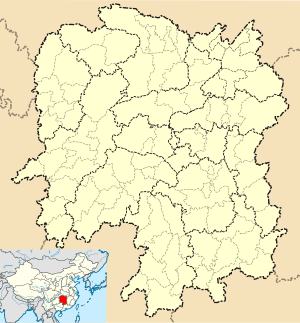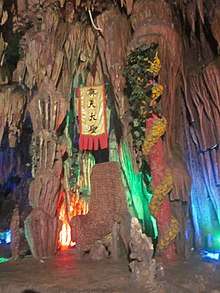Lengshuijiang
| Lengshuijiang 冷水江市 | |
|---|---|
| County-level city | |
 Lengshuijiang Location in Hunan | |
| Coordinates: 27°41′10″N 111°26′10″E / 27.686°N 111.436°ECoordinates: 27°41′10″N 111°26′10″E / 27.686°N 111.436°E[1] | |
| Country | People's Republic of China |
| Province | Hunan |
| Prefecture-level city | Loudi |
| Area[2] | |
| • Total | 436.28 km2 (168.45 sq mi) |
| Population (2010)[3] | |
| • Total | 327,279 |
| • Density | 750/km2 (1,900/sq mi) |
| Time zone | UTC+8 (China Standard) |
| Postal code | 4175XX |
Lengshuijiang (Chinese: 冷水江; pinyin: Lěngshuǐjiāng) is a county-level city in Hunan Province, China, it is under the administration of Loudi prefecture-level City. Located on the central Hunan, the city is bordered to the north and west by Xinhua County, to the south by Xinshao County, to the east by Lianyuan City. Lengshuijiang City covers 439 km2 (169 sq mi). As of 2015, it has a registered population of 370,300 and a resident population of 342,700.[4] The city has 4 subdistricts, 5 towns and a township under its jurisdiction, the government seat is Lengshuijiang Subdistrict (冷水江街道).[5]
Lengshuijiang was incorporated as a city in 1960 which created from parts of Xinhua County. It is a resource-based city which is rich in antimony, it has the world's largest antimony mine (more than 50% of the world's production of antimony).
Subdivision
According to the result on adjustment of township-level administrative divisions of Lengshuijiang on November 23, 2015, the divisions of Lengshuijiang, according to the result on adjustment of township-level administrative divisions of Lengshuijiang on November 23, 2015: Kuangshan Township was merged into Xikuangshan Subdistrict, Yankou Town was merged into Duoshan Town, Zilong Township was merged into Zhadu Town, Panqiao Township, Tongxing Township and Maoyi Town were revoked.[6]
| English name | Chinese name | Population (2015) | Area (2015) | Notes |
|---|---|---|---|---|
| Buxi Subdistrict | 布溪街道 | 20,000 | 12.24-square-kilometre (4.73 sq mi) | |
| Lengshuijiang Subdistrict | 冷水江街道 | 81,200 | 15.9-square-kilometre (6.1 sq mi) | |
| Shatangwan Subdistrict | 沙塘湾街道 | 49,000 | 47.57-square-kilometre (18.37 sq mi) | |
| Xikuangshan Subdistrict | 锡矿山街道 | 30,500 | 67.05-square-kilometre (25.89 sq mi) | |
| Duoshan Town | 铎山镇 | 47,300 | 52.29-square-kilometre (20.19 sq mi) | |
| Heqing Town | 禾青镇 | 36,800 | 44.44-square-kilometre (17.16 sq mi) | |
| Jinzhushan Town | 金竹山镇 | 15,000 | 26.6-square-kilometre (10.3 sq mi) | |
| Sanjian Town | 三尖镇 | 20,000 | 36.8-square-kilometre (14.2 sq mi) | |
| Zhadu Town | 渣渡镇 | 32,000 | 74.97-square-kilometre (28.95 sq mi) | |
| Zhonglian Township | 中连乡 | 27,500 | 53.03-square-kilometre (20.47 sq mi) |
Geography

Lengshuijiang is located in the middle of Hunan province, on foothills of the Xuefeng Mountains and along the Zi River. The city is bordered to the north by Anhua County, to the east by Lianyuan, to the south by Xinshao, and to the west and northwest by Xinhua. The city has a total area of 439-square-kilometre (169 sq mi).
River
Zi River, is a tributary of Xiang River, flows through the city, draining an area of 326.5 square kilometres (126.1 sq mi).
Reservoirs
Zhoutou Reservoir (周头水库) is a reservoir and the largest body of water in the city.
Mountains
There are 123 mountains in the city over 400-metre (1,300 ft) above sea level, and 20 of them are more than 800-metre (2,600 ft).[7] The highest natural elevation in Lengshuijiang is 1,073-metre (3,520 ft) at Zushiling Ridge (祖师岭).[8]
Climate
Lengshuijiang is in the subtropical monsoon climate zone, with an average annual temperature of 16.7 °C (62.1 °F), total annual rainfall of 1,354-millimetre (53.3 in), a frost-free period of 269 days and annual average sunshine hours in 1401.8 hours. It exhibits four distinct seasons.[7]
| Climate data for Lengshuijiang (1981−2010) | |||||||||||||
|---|---|---|---|---|---|---|---|---|---|---|---|---|---|
| Month | Jan | Feb | Mar | Apr | May | Jun | Jul | Aug | Sep | Oct | Nov | Dec | Year |
| Record high °C (°F) | 25.9 (78.6) |
30.2 (86.4) |
35.0 (95) |
35.7 (96.3) |
36.5 (97.7) |
37.2 (99) |
39.5 (103.1) |
40.0 (104) |
38.4 (101.1) |
35.4 (95.7) |
31.5 (88.7) |
24.3 (75.7) |
40 (104) |
| Average high °C (°F) | 8.6 (47.5) |
10.6 (51.1) |
15.1 (59.2) |
21.5 (70.7) |
26.5 (79.7) |
29.5 (85.1) |
32.8 (91) |
32.2 (90) |
28.2 (82.8) |
22.8 (73) |
17.6 (63.7) |
12.0 (53.6) |
21.5 (70.6) |
| Daily mean °C (°F) | 5.0 (41) |
7.0 (44.6) |
10.9 (51.6) |
16.9 (62.4) |
21.6 (70.9) |
25.0 (77) |
28.0 (82.4) |
27.0 (80.6) |
23.2 (73.8) |
17.9 (64.2) |
12.7 (54.9) |
7.4 (45.3) |
16.9 (62.4) |
| Average low °C (°F) | 2.2 (36) |
4.3 (39.7) |
7.7 (45.9) |
13.3 (55.9) |
17.7 (63.9) |
21.5 (70.7) |
24.1 (75.4) |
23.4 (74.1) |
19.5 (67.1) |
14.4 (57.9) |
9.0 (48.2) |
3.9 (39) |
13.4 (56.2) |
| Record low °C (°F) | −6.3 (20.7) |
−4.7 (23.5) |
−1.6 (29.1) |
2.1 (35.8) |
7.5 (45.5) |
12.2 (54) |
17.1 (62.8) |
16.5 (61.7) |
12.0 (53.6) |
2.9 (37.2) |
−1.8 (28.8) |
−8.2 (17.2) |
−8.2 (17.2) |
| Average precipitation mm (inches) | 67.9 (2.673) |
83.8 (3.299) |
118.4 (4.661) |
176.2 (6.937) |
189.5 (7.461) |
235.1 (9.256) |
153.9 (6.059) |
142.0 (5.591) |
77.6 (3.055) |
84.2 (3.315) |
71.0 (2.795) |
46.3 (1.823) |
1,445.9 (56.925) |
| Average relative humidity (%) | 78 | 79 | 80 | 80 | 80 | 82 | 77 | 79 | 78 | 78 | 75 | 74 | 78 |
| Source: China Meteorological Data Service Center | |||||||||||||
Economy
As of 2016, Lengshuijiang's GDP is CN¥ 28,880,000,000. The city's economy is dominated by coal resource, which is venerated as "Coal Sea in Jiangnan".[9]
Demographics
Population
As of 2016, the National Bureau of Statistics of the People's Republic of China estimates the city's population now to be 372,400. Lengshuijiang is mainly Han nationality with Miao, Hui and Tujia ethnic minorities.[10]
Language
Mandarin is the official language. The local people speak Loudi dialect.
Religion
The city hosts religious institutions of various faiths, including Christianity, Islam, Chinese folk religion, Buddhism, and Taoism.
Education
As of 2016, Lengshuijiang has 2 high schools, 11 middle schools, 57 primary schools and 78 kindergartens.[10]
Lengshuijiang Normal School is an institution of higher education in Lengshuijiang, which has no university.
Transportation
Railway
The Shanghai–Kunming railway, from Shanghai to Kunming, southwest China's Yunnan province, through the middle of the city.[8]
The Shanghai–Kunming high-speed railway, also passes through the southwestern city.[8]
Expressway
The S70 Loudi–Huaihua Expressway, more commonly known as "Louhuai Expressway", is a west-east highway passing through the southwestern city.[8]
Provincial Highway
The Provincial Highway S312 runs east to west through the city.[8]
The Provincial Highway S217 is a north-south highway passing through the town of Sanjian.[8]
Tourism

Boyue Cave is situated in Zhonglian Township. It is the most well-known tourist spot in the city. The spot was used for location filming of the 1986 fantasy television series Journey to the West.
Dachengshan Scenic Spot (大乘山风景名胜区) is a provincial-level scenic spot in southeastern Lengshuijiang.
Zhoutouhu Holiday Resort (周头湖度假区) is a popular attraction in the city for recreation for residents.
Notable people
- Duan Chuxian (段楚贤; 1889–1954), entrepreneur.
- Jiang Yunqing (姜云清; 1914–2000), a notable soldier in the Red Army.
- Su Jing (苏镜; 1912–1989), politician.
- Su Peng (苏鹏; 1880–1853), revolutionist.
- Xie Bingying (谢冰莹; 1906–2000), writer.
- Xie Dingzhong (谢定中; born 1938), chemist.
- Zeng Jie (曾杰; 1886–1941), mathematician.
- Zhu Jiang (朱江; 1916–1988), an official in the People's Liberation Army.
References
- ↑ Google (2014-07-02). "Lengshuijiang" (Map). Google Maps. Google. Retrieved 2014-07-02.
- ↑ Loudi City Land Use Plan (2006–20)/《娄底市土地利用总体规划(2006-2020年)》.(in Chinese) Accessed 8 July 2014.
- ↑ 娄底市2010年第六次全国人口普查主要数据公报 (in Chinese). Loudi People's Government. Retrieved 9 July 2014.
- ↑ the population of Lengshuijiang City in 2015: according to Statistical Communiqué of Lengshuijiang City on the 2015 National Economic and Social Development, see 冷水江市2015年国民经济和社会发展统计公报, or ahmhxc.com
- ↑ the divisions of Lengshuijiang City (November 23, 2015): according to the result on adjustment of township-level administrative divisions of Lengshuijiang city on November 23, 2015, see rednet (November 23, 2015): 《关于同意冷水江市乡镇区划调整方案的批复》(湘民行发〔2015〕66号) also see: Lengshuijiang.gov
- ↑ 冷水江市乡镇区划调整方案:调整后下辖1乡5镇4街道. rednet.cn (in Chinese). 2015-12-04.
- 1 2 地理环境 [Geography of Lengshuijiang]. lsj.gov.cn (in Chinese). 2015-09-18.
- 1 2 3 4 5 6 Zhang Hong, ed. (2018). "Lengshuijiang and Lianyuan" 《冷水江市和涟源市》. 《中国分省系列地图册:湖南》 [Maps of Provinces in China: Hunan] (in Chinese). Xicheng District, Beijing: SinoMaps Press. pp. 172–173. ISBN 978-7-5031-8949-4.
- ↑ 自然资源 [Natural resources]. lsj.gov.cn (in Chinese). 2015-09-18.
- 1 2 冷水江市2016年国民经济和社会发展统计公报. lsj.gov.cn (in Chinese). 2017-04-21.
External links